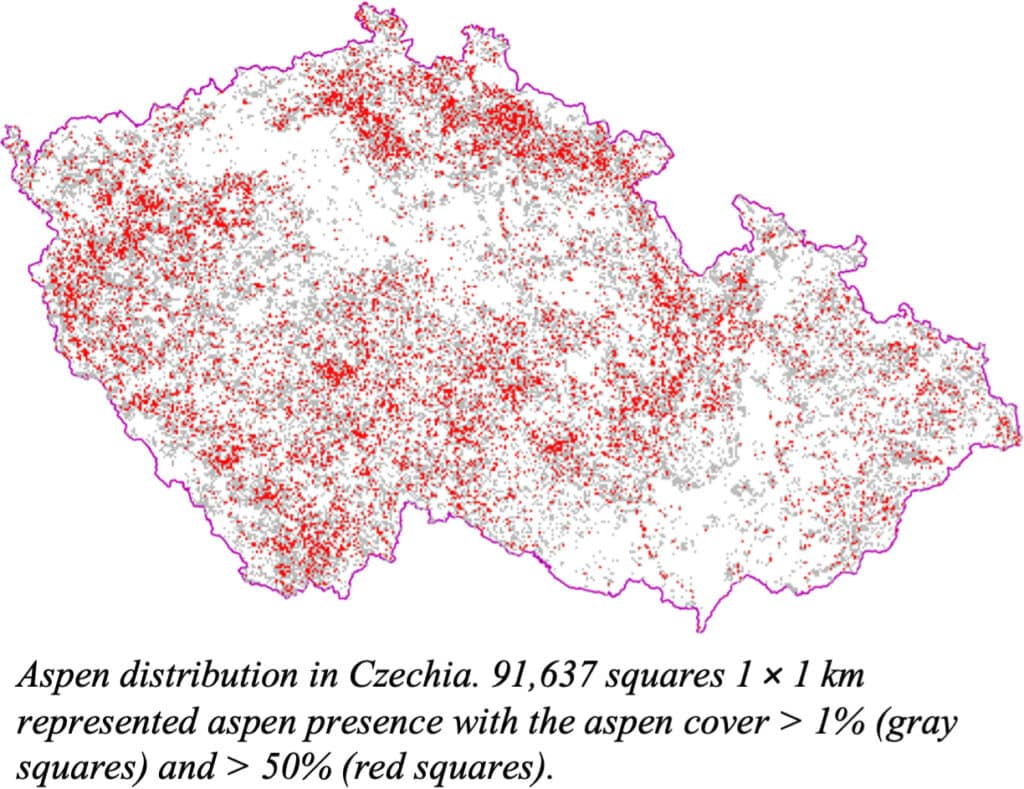One of Europe’s tree-based solutions to the climate crisis could be “hiding in plain sight” – with “neglected” species showing huge potential for recovery, improved species and resilience as the climate warms.
That is according to new research from scientists in the United States and the Czech Republic, who claim that Central Europe has “ample habitat” for Eurasian Aspen – and that the Bark Beetle infection, now ravaging spruce, “aspen has naturally found its way into central European forests.”
Published in PLOS ONE, Eurasian aspen (Populus tremula L.): Central Europe’s keystone species ‘hiding in plain sight comes after a separate study warned that the English Oak is one of the only timber-producing species that can withstand changes over the next 50 to 100 years.
“The Eurasian aspen, and aspen species globally, are home to vast populations of other dependent plants and animals,” according to lead researcher Antonin Kusbach, an applied ecologist at Mendel University in Brno, in the Czech Republic – in the heart of the new potential habitat.
“Additionally, aspen systems regenerate and colonise new areas quickly, so these types of forests are ideally adaptive to increased forest disturbances like fire, diseases, insect infestations, and windstorms, widely anticipated under climate warming scenarios.”
Using field measurements, remote sensing technology and sophisticated analytical techniques, the scientists surveyed more than four million locations in “the realised niche” – an area of the Czech forest terrain that can also be “modelled across Central Europe.”
Wood Central understands that aspen forests were once widespread across the terrain before being replaced by monotypic conifer species – used by commercial forestry to supply the EU and global markets with lumber. However, that could, and according to the scientists, should change in the future.
“A course correction in European forest management could help reestablish these amazing forests,” according to co-author Paul Rogers of the Western Aspen Alliance, Ecology Center, and Department of Environment and Society at Utah State University. “Within every acre of aspen forest that returns, plant and animal diversity will flourish.”

The Eurasian Aspen, Populus tremula, is one of six species of Aspen in the Populus genus, which stretches across much of the Northern Hemisphere.
Jointly, these species harbour outsized biodiversity relative to surrounding forests. Eurasian Aspen spans the breadth of Europe and Asia. The quaking aspen, Populus tremuloides, is the most widely distributed tree in North America, where it is also known as a keystone species, facilitating elevated biodiversity even as climates change.
“It’s sometimes said that you could walk from coast to coast in North America and never leave the shade of an aspen tree,” according to Dr Rogers, who said that whilst that might not be true, “it speaks to the flexibility and adaptability of these forests. Now, we better understand the great potential Aspen has to thrive across Europe, as well.”
Eurasian aspen has enormous ecosystem potential.
While the species can be used in veneer, paper production, charcoal, and chip wood, it has enormous ecological value. It hosts more species than any other boreal tree and provides habitat for a wide range of mammals, birds, insects, and fungi.
In addition, it helps stabilise denuded sites, especially on shallow rocky soils and steep slopes, helps with soil erosion, and sequesters far more soil carbon than conifer forests—unlocking Europe’s carbon potential.
- To learn more about why Europe’s forest inventory is at risk thanks to global warming, visit Wood Central’s special feature from earlier this month. To find out how Europe’s new “Nature Restoration Law” is reshaping European forests – and can potentially drive new tree species – visit Wood Central’s article from last year.






